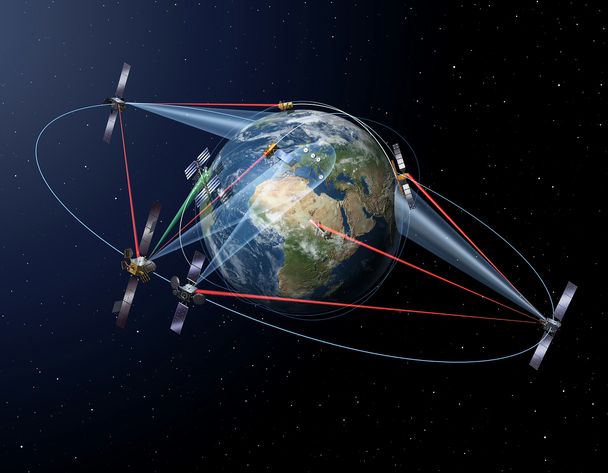Laser Communications Maturity

Laser Communications Maturity
In the previous article "Laser communications background", Yoann Jezequel, Innovation and Future Concepts Strategic Manager, explained the various characteristics of laser communications. Laser communication technologies are the next revolution in satellite communications (satcom), bringing unprecedented transmission rates, data security and resilience to meet military and commercial needs in the next decade.
In this article, Yoann sheds light on the level of maturity of these communications and the different developments Airbus has achieved over the last few years.
Line-of-sight (LOS) ground FSO communications
Fixed short distance line-of-sight (LOS) ground FSO communications, are mature, off-the-shelf equipment available to the commercial market. For example, a laser link of a few kilometres between two pylons. Mobile LOS FSO communications are less extensively developed but have potential in the military sector (FSO communications between ships, vehicles, aircraft, etc.). We can speculate that commercial mobile FSO products will appear on the Defence market in the coming years.
Satellite FSO communications
Inter-satellite links (ISL)
FSO communications by satellite are, for their part, considered mature for inter-satellite links. Early in the 2000's, the first inter-satellite laser links were achieved through the SILEX project conducted by the ESA, the CNES and Airbus. At that time, this 50 Mbit/s laser link allowed the transfer of images from the LEO observation satellite SPOT4 to the geostationary satellite ARTEMIS, which then transmitted them to Toulouse via a radio link.
Since then, an operational service called SpaceDataHighway has been deployed thanks to a partnership between ESA and Airbus. Providing a unique service in the operational world since 2016, the SpaceDataHighway is a constellation of two geostationary nodes allowing the transfer of observation data from LEO satellites (SENTINEL satellites) via a system of geostationary relays. Thanks to this service, Airbus makes 34 laser links daily and retrieves these observation data in near real-time. The most advanced company of optical ISL solutions is German SME TESAT. They have put in orbit dozens of optical communication payloads.
On the military side, the US DoD Space Development Agency (SDA) LEO constellation named Transport Layer, will use laser inter-satellite links. This capacity is strategic to provide an end-to-end high throughput space transport layer and limit the number of the ground anchoring station.
"Cross-atmospheric" links (space-ground links)
In 2006, the LOLA project supervised by Airbus and the DGA (“Direction Générale de l'Armement”, the French defence procurement agency), was the first to make laser connections between the Artemis satellite and an aircraft in flight. Nevertheless, and despite this feat, "cross-atmospheric" links (i.e. laser links between a satellite and the ground) are less mature. Unlike ISLs, they come up against additional physical constraints and complex problems associated with atmospheric turbulence.
These technological elements have been evolving rapidly over the last few years, driven in particular by the DLR in Germany and the CNES and Airbus in France along with the ecosystem of associated SMEs and start-ups, through the DYSCO and CO-OP projects. In 2023 Airbus will send the TELEO demonstrator into geostationary orbit delivering ultra high-speed broadband satellite-ground laser links.
In 2023, French startup Cailabs will demonstrate a high throughput cross-atmospheric link with a LEO satellite.
Regarding aero connectivity, Airbus and the Netherlands Organisation for Applied Scientific Research (TNO) launched a program a few years ago to develop a laser communication terminal for aircraft, known as UltraAir.
This project, co-financed by Airbus, TNO and the Netherlands Space Office (NSO), is part of the European Space Agency’s (ESA) ScyLight (Secure and Laser communication technology) program. It covers the design, construction and testing of the technology demonstrator. This program is a key milestone in the roadmap of Airbus’ overall strategy to drive laser communications further, by bringing forward the benefits of this technology as a key differentiator for providing Multi-Domain collaboration solutions for Government and defence customers.
In summary, the space ecosystem is starting to bloom and technologies are maturing rapidly. Airbus, world leader in this area, plans to deploy Tbit/s satellite laser communication solutions before the end of this decade.
The space fibre is on its way!